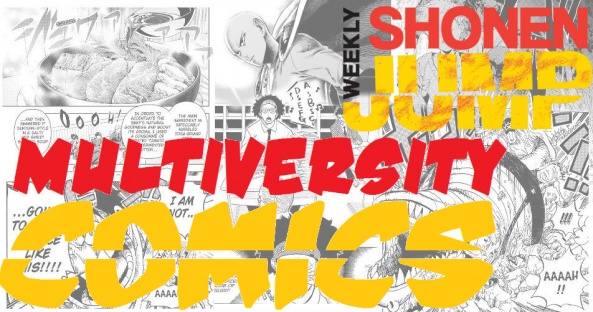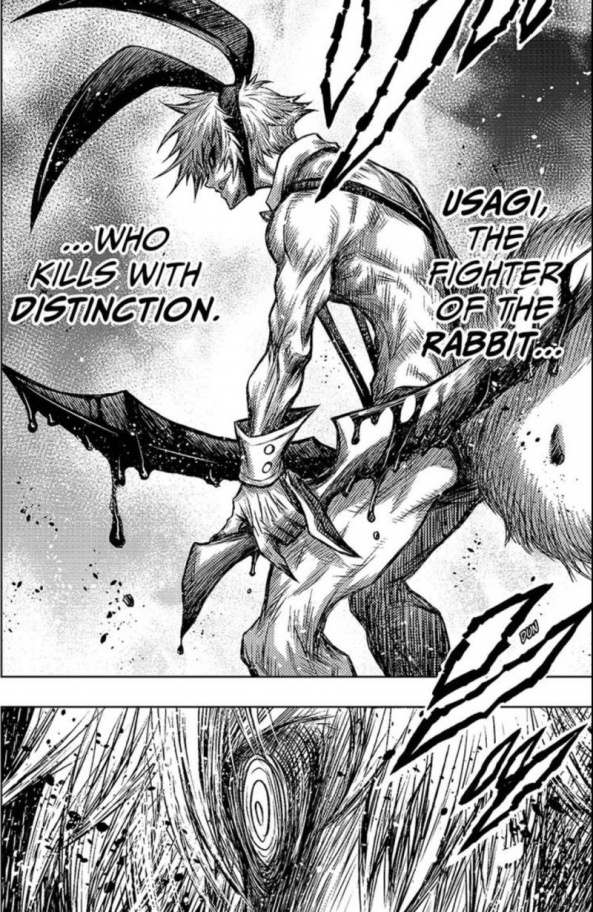
Welcome to This Week in Shonen Jump, in which a rotating duo of Multiversity staffers take a look at two stories contained in each installment of Viz Media’s Weekly Shonen Jump. For the uninitiated, Weekly Shonen Jump is an anthology that delivers more than 200 pages of manga of all varieties. We hope that you’ll join us in exploring the world of Weekly Shonen Jump each week. If you are unfamiliar, you can read sample chapters and subscribe at Viz.com.

This week, Vince and Zach check in with “We Never Learn” and “Juni Taisen: Zodiac War.” If you have any thoughts on these titles, or “My Hero Academia,” “Yu-Gi-Oh Arc V,” “Black Clover,” “One Piece,” “Food Wars,” “The Promised Neverland,” “Robot X Laserbeam,” or “Dr. Stone,” let us know in the comments!

We Never Learn – Chapter 32: An Elder Sees an X Future with Naïve Honesty
Written & Illustrated by Taishi Tsutsui
Review by Vince J Ostrowski
Here at Multiversity, we’ve generally panned “We Never Learn” as trite, regressive, over-sexualized harem manga. That includes yours truly, who reviewed the opening chapter of the story many months ago and knocked it for the same reasons. I went back to check in on it this week just to see if it would be the same old story, and for the most part it was, but there was also a real sense that this manga could have been something much better with just a few tweaks here and there.
For one thing, Chapter 32 is shorter on overt perversion than previous chapters have been. There’s a joke about a girl’s (clothed) chest blurring for the camera while they’re trying to pose for a photo. It’s not a great joke, but it’s as tame as any similar joke in beloved manga like, say, “Dragon Ball.” Things haven’t changed much, plotwise. Nariyuki is still tutoring each girl on the subject for which she shows an individual weakness. One of the newer girls, Asumi, wants to go to medical school, but in this case Biology is her weak spot. She works at a maid café to pay her way through med school prep and while other characters comment on how “seedy” the job is, it’s really not presented as gratuitously as such on the page. It’s the kind of restraint that “We Never Learn” rarely shows. This situation actually produced a chuckle as a series of deceptions and misunderstandings resulted in the girl’s father unexpectedly wanting to accept Nariyuki as a surrogate son-in-law.
Taishi Tsutsui’s art and layouts are fairly simple, but nonetheless cute enough. I think that’s part of the problem, actually. “We Never Learn” visually presents itself as a more innocent and wacky affair than it ends up being much of the time. In this chapter, that problem didn’t really crop up, and I was able to enjoy the art for its cartoon expressiveness. Towards the end of the chapter, there are even some interesting panel layouts that mirror one another. The main character of the particular page is positioned oversized on the right side of each page, while interstitial action and dialogue happen to their left. It doesn’t accomplish much from a storytelling perspective, but it’s an interesting layout to look at and seems to be a conscious choice that Tsutsui is making from a stylistic standpoint. It almost appears to be a visual signature of the artist, and I appreciated it on that level.
There’s a parallel universe where “We Never Learn” could have been an inconsequential, but sort of fun harem manga if it were a little more interested in the emotional stakes of these characters rather than putting them in more scandalous positions. Chapter 32 is a peek into that, because it focuses on themes of setting expectations for yourself, individualism apart from the expectations of others, and the idea that everyone has some sort of intellectual weakness or blindspot. Even Asumi’s father, a doctor himself, expresses regret about a shortcoming in his own personality. Asumi wants to be a doctor, because she wants to be a doctor and is willing to work as hard as she has to. It’s made clear that she’s not doing it to follow in her father’s footsteps, and her father makes it known that that’s not something he’s pressing onto her either. For one chapter anyway, I could see this character as a real person, struggling, rather than the object of horndogged affections that these characters have been played for. I think it’s probably too late to hope that the book turns things around, and even this issue wasn’t particularly funny or entertaining outside of a couple jokes I may have already mentioned. But Chapter 32 did make me think that at the very least “We Never Learn” might have been a series that was worth breezing through on a weekly basis, in another life.
Continued belowFinal Verdict: 6.0 – “We Never Learn” can’t really redeem itself at this point, but this chapter showed a side of itself that we unfortunately haven’t gotten to see very often

Juni Taisen: Zodiac War Chapter 1
Written and illustrated by Akira Akatsuki
Reviewed by Zach Wilkerson
“Juni Taisen: Zodiac War” takes Viz and Weekly Shonen Jump by storm this week with both a preview of the upcoming novel within the pages of WSJ and the first chapter of the manga adaptation, set to run simultaneously with Japan on viz.com. Set against this media blitz, Juni Taisen is immediately captivating and intriguing. The core concept, a themed battle royale featuring avatars of the Chinese zodiac, is bolstered by unique uniquely bizarre character designs by Hikara Nakamura. However, underneath the flashy exterior is a product that falls short on nearly every level.
This lengthy opening chapter is overloaded with exposition as it attempts to establish its large, quirky cast, as well as the contrived and obtuse rules of the titular “Zodiac War.” Each character bears a memorable design and trait, but the rushed nature of the chapter leaves room for little else. The chapter sets up Toshiko Inō, “the Boar,” as a de facto “protagonist,” along with Navi, a reporter who acts as a point of view character. Nevertheless, the chapter lacks a strong anchor for the reader to ground to as the plot flies in fits and bursts from moment to moment.
Part of my aloofness with this chapter comes from an occasionally odd English translation. Each character has a description for how he or she kills, ranging from rational to nonsensical. The aforementioned Boar, quite reasonably, “kills in abundance,” while the Chicken…”kills by pecks?” I don’t speak or read Japanese, so I lay no blame at the feet of the translators. Rather, I write this off as a moment where an idea or concept just doesn’t quite pass the language barrier fully intact.
For all its inconsistencies and shortcomings, this first chapter could come off as delightful camp. That is, if it wasn’t so soul crushingly serious. It’s hard to pick out the biggest edgelord of the bunch (ok, maybe not, it’s definitely the Rabbit). DC Rebirth may have 3 Jokers running around, but “Juni Taisen” has over a half dozen. That, my friends, is Twisted™. Some characters, like the peace loving Monkey and the wizened mystical Sheep, work to break up the monotony of the otherwise bloodthirsty cast.
Visually, the book is quite strong, which is its saving grace. The characters are all well designed and highly emotive. The amount of detail contained within these 70-odd pages leaves this reviewer gobbsmacked. Most of this issue consists of a dozen or so figures standing around a room, a fact Akatsuki masks well with his dynamic style and panel pacing. That said, it will be exciting to get to see him flex his artistic muscle in a larger battle sequence.
From “Battle Royale,” to “Hunger Games,” to PlayerUnknown’s Battlegrounds, it’s abundantly clear that concept of a free-for-all death match is highly appealing. This first chapter rushes through the obligatory table setting with the intent of getting to that main event that people so seemingly crave. By chapter’s end the Zodiac War kicks of with a “bang,” though in a metatextual sense it begins with just the opposite. I don’t mean to be unfairly critical of this chapter due to its foundational nature. Rather, it’s the reliance on tired tropes, with little depth to back them up, that causes this book to commit several mortal manga sins.
Final Verdict: 3.0 – An interesting concept marred by rushed execution, plot contrivances, and exposition. There’s certainly the germ of a good story here, something future chapters can cultivate and grow.






